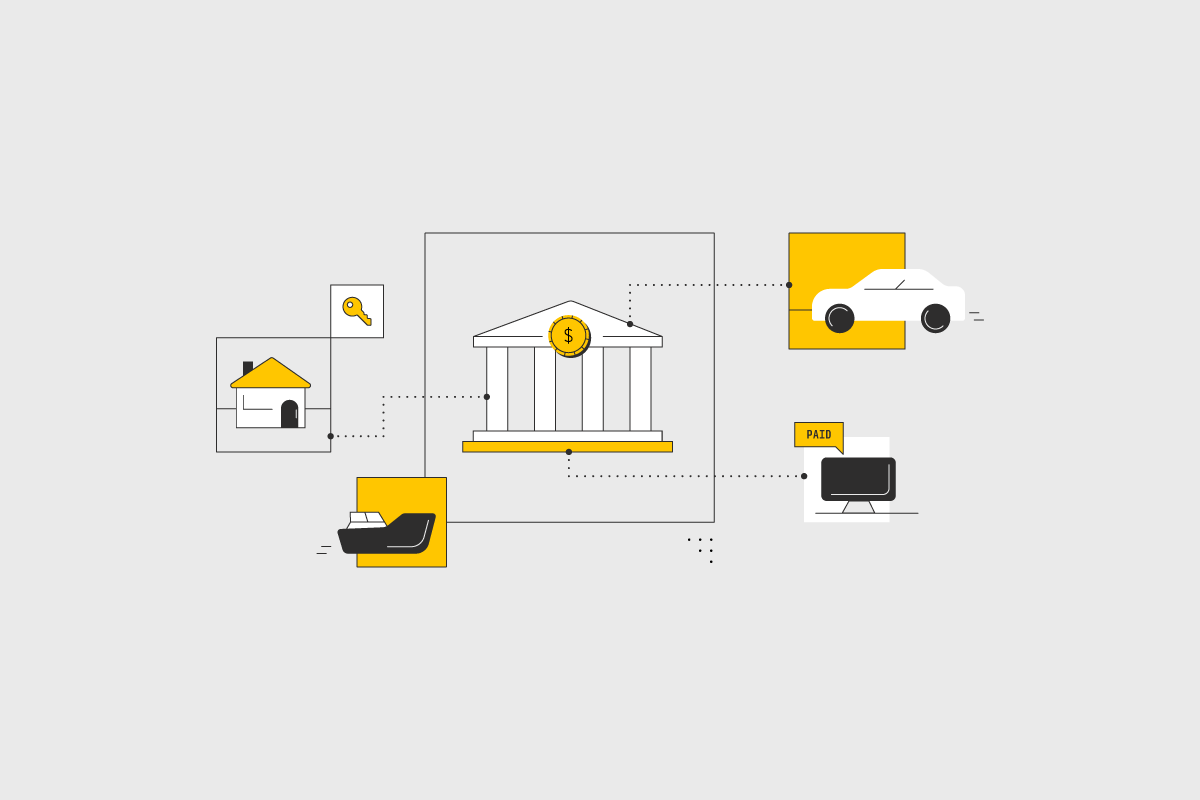Blog
Six industries that can benefit from open banking
March 16, 2023
Editorial Team

In 2022, the value of the open banking market size was already $20.08 billion, and between 2023 and 2030, it's expected to "grow at a Compound Annual Growth Rate (CAGR) of 27.2%." And this isn't necessarily limited to financial services.
In reality, the benefits that make open banking appealing are transferable. The technology, such as application programming interfaces (APIs), can empower other industries to be just as secure, efficient, and consumer-friendly.
Retail industry can make use of flexible payments
Open banking can improve retail customer and merchant experience through more security, flexible payments, and faster transactions.
The growth of open banking in the retail industry was predicted years ago: A 2017 survey showed that 69% of respondents expected application programming interfaces (APIs) to be the leading payment technology in 2022 and beyond.
With open banking, retailers can accept payments from a customer's bank account; it is faster and more secure than traditional payment methods like debit or credit cards, which are more prone to fraudulent transactions. In addition, by allowing paperless payments, retailers can reduce the risk of financial losses.
Additionally, by offering flexible payment options, retailers can enhance the customer experience, making it easier for customers to shop at their stores. By doing so, customers are more likely to return to the merchant's store for future purchases due to the convenience and seamless buying experience.
Some retailers are already optimizing these benefits. According to an article on AM Online, open banking is expected "to become the dominant form of payment in [car] dealerships."
Cars are one of the most expensive purchases for any consumer, and the payment process isn't the smoothest experience. In the UK, Germany, France, and Portugal, fintech company Truelayer partnered with Cazoo so customers can make easy, secure payments to car dealerships directly through their bank account and mitigate the challenge of transaction limits.
In the US, Link Money offers guidelines on choosing the right provider based on your business needs.
Healthcare organizations can securely manage patient financial data
In the US, healthcare is often expensive and involves the complex processing of financial information. Healthcare providers have to map out services to insurance providers and bill consumers for their co-pay, and in some cases, directly bill consumers for the entire service if they don't have health insurance.
According to an article in the Chron, the most critical objectives of healthcare financial management in the future include the following:
Generate income for the hospital
Protect the tax status
Monitor "internal spending"
Influence third-party payers such as insurance companies
Open banking is set up to handle complex data which can help healthcare providers with their financial goals. It can help hospitals reduce financial losses by providing up-to-date information on internal transactions in real time, thus reducing the misappropriation of hospital funds.
On the flip side, open banking also allows patients to utilize APIs for their payments, meaning funds are directly debited from the patient's bank account, ensuring the hospital gets paid—on time. Patients also benefit from flexible payment options.
For example, in Australia, fintech company Medipass partnered with the National Australia Bank to use APIs to connect the healthcare ecosystem, i.e., the hospital, consumer, insurance providers, government health service, and the bank. This partnership allows patients to view the cost of their treatment upfront and check their insurance coverage before booking an appointment.
Lenders can refine risk assessment
Open banking minimizes risk for lenders and makes financial services more inclusive by providing a comprehensive view of a consumer's financial health. A study by Boston Consulting Group (BCG) and Younited found that credit approval rates were much higher when open banking was used in decision-making, particularly for underserved segments like low-income and younger customers.
Open banking allows banks and third-party providers to share financial data securely through APIs. When consumers link their bank accounts to a third-party application, lenders can access the consumer's spending habits, income, and overall creditworthiness in real-time. This process speeds up lending as institutions have immediate access to a consumer's complete financial health.
In a 2021 case study, a luxury car manufacturer wanted to improve the risk assessment process for customers applying for vehicle finance. So the company utilized Experian's credit scores and open banking to better assess a consumer's financial health and minimize "manual intervention in creditworthiness." The result? There was a 9% increase in instant decisions, and automatic acceptance of applications increased by 5%.
Lenders can now consider factors other than credit score, which allows financial services to be more inclusive by offering products to consumers that traditional institutions may not have considered. Moreover, access to consumer information fosters competition in financial services as providers can offer tailored products to consumers.
Ultimately, open banking benefits lenders and consumers by improving efficiency, reducing risk, and making financial services more accessible and inclusive.
Real estate industry can improve property valuation and the lending process
Open banking improves risk assessment in real estate, streamlines mortgage applications, increases transparency, and makes it possible to value properties in real-time.
Real estate relies heavily on lenders. Open banking offers real-time financial data, both the consumer's and the market's, so lenders can quickly and easily assess property value and reduce the risk of overvaluing or undervaluing a property.
Moreover, when underwriters access a consumer's bank accounts, they can assess income, spending habits, and available downpayment more accurately, reducing the risk of skipped payments.
Open banking also makes room for automation and reduces manual paperwork, which lowers inaccuracies and speeds up the mortgage approval process.
As an article in Canadian Mortgage Trends states:
Reduced client stress, particularly involving the collection of paperwork concerning their income and down payment
Less work for underwriters
More automation potential of manual tasks
Lower chances of fraud as the financial verification documents come direct from the source
Faster mortgage approvals
In Canada, fintech company Flinks is already improving the mortgage loan process by removing steps in the application through open banking. This partnership streamlines the home-buying process and makes it pleasant for all parties involved.
Insurance companies can modernize processes
Open banking improves the insurance industry by streamlining the claims process and making the landscape more competitive. In addition, insurtech companies can use APIs to verify and analyze a client's financial data.
"Insurance, by its nature, is the law of large numbers. Ask any actuary. The more data you have, the better you can underwrite a risk. The more data an underwriter has – including banking data – the better for the consumer," says Steve Masnyk, an insurance lobbyist.
Open banking can lower the need for paperwork because insurance companies can analyze the data and make informed decisions in real-time when they can access consumers' complete financial health. With this data, insurers can offer risk-based pricing to potential customers and reduce the chances of fraud.
However, companies must be ready for the changes for open insurance to succeed. A recent WTW article identifies five building blocks for insurer success in open insurance:
Maximize cloud computing and infrastructure
Enhance the "ability to plug into a connected ecosystem"
Automation
Data insights
Digital business services and platforms
Finally, open banking fosters competition in the insurance market. Insurers can offer customized products according to individual needs by analyzing consumer spending patterns and tailoring products based on their risk profile.
Subscription-based businesses can reduce churn
Subscriptions like movie streaming services, software, storage units, daycare, and even utilities or rent, often rely on credit cards for recurring payments. "In Australia, 70 percent of the population use subscriptions," says Carolyn Breeze, ANZ general manager at GoCardless, in an article about how open banking will transform the subscription industry.
"Consumers are gravitating towards usership versus ownership, and this is reflected in every aspect of their daily lives [...] we now want the freedom to pay-as-we-go in installments, otherwise known as micropayments."
Credit cards come with a lot of volatility such as expiration, loss, or theft of the card which can result in the business not getting paid on time, or at all due to involuntary churn. With open banking, card payments are eliminated, as customers make payments straight from their bank accounts. Subscription-based companies can rest easy knowing they'll get paid directly from the customer's bank account every month.
Open banking can benefit subscription-based businesses in multiple ways:
Streamline payments by directly getting paid from the customer's bank account. Customers are less likely to miss payments or incur late fees because the subscription fee is deducted from their account every month.
Reduce fraud by verifying the customer's identity, ensuring you offer your services to the right individual.
Eliminate costly processing fees that come with credit or debit card transactions. For example, a 2.5% processing fee on 100,000 transactions worth $30 each can quickly add up, costing you $75,000 in transaction fees alone.
Open banking empowers customers to manage their subscriptions through frictionless and intuitive payment options. For example, Visa partnered with a subscription management service in Europe that reduced incoming call volumes by 27,000 within three months of rollout. In addition, customers used their banking apps more as subscription management was integrated with their existing banking application, improving the overall customer experience.
For subscription companies looking to understand how they can improve their business through open banking, Link Money suggests "a scalable way subscription merchants can fight inflation and reduce operational cost by 2%.”
When industries use open banking, it makes the economy better
Open banking, at its core, expands the market. When more industries fully utilize its benefits, their services are accessible to more individuals from all population segments. By promoting financial inclusion, open banking stimulates economic growth and continues to evolve and will contribute to technological progress in many industries, improving the economy.